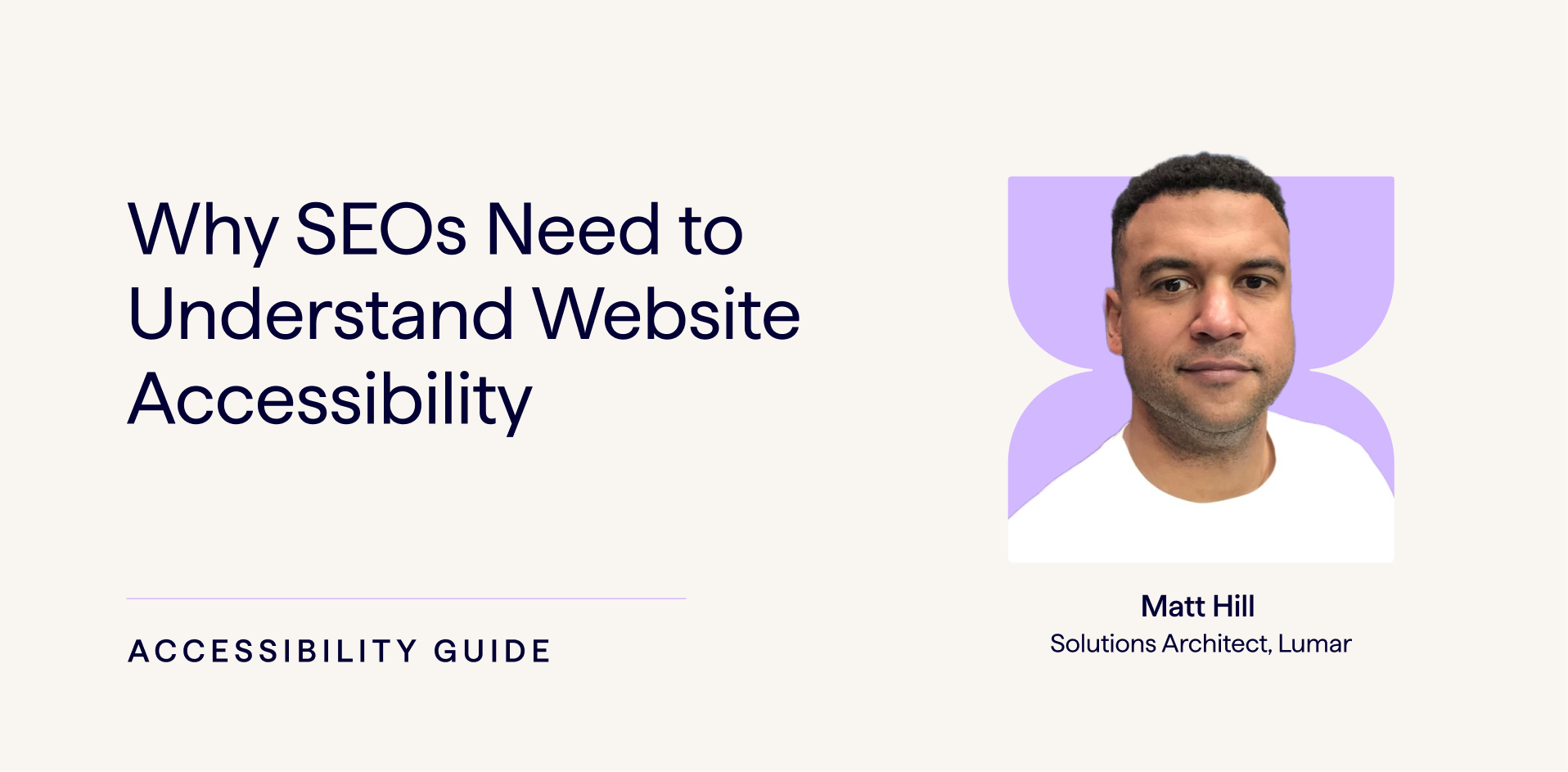
When I began my SEO journey in 2008, I didn’t know much. Pretty much every search-related blog post I read in the early days referenced recommendations from the then-head of Google search quality, Matt Cutts; one of Google’s earliest hires. But the discourse among SEO practitioners was split. Some wholeheartedly accepted the messaging they received from the public figures employed by Big Search. Others insisted that the Google-sanctioned advice couldn’t be trusted, or was designed to throw SEOs off of their algorithms, and continued to keyword-stuff within title tags, image filenames, alt tags — you name it.
Even now, SEOs who are nowhere near embracing “black hat” optimization strategies still often view the tactics they used through a narrow lens, focusing entirely on the immediate search benefits they could achieve instead of seeing the bigger picture of why certain website development tactics were prioritized by Google in the first place. The value of structured data, for some SEOs, is often purely about gaining those sweet, sweet rich snippets and enhanced search results. For some SEOs, writing non-generic link text instead of “click here” or optimizing breadcrumb navigation are practices that are adopted only to complement search ranking gaps within a content strategy.
This status-quo mindset of just wanting to “beat Google” and conquer the algorithms seems disingenuous to me. While Google figureheads can sometimes be a bit ambiguous about what exactly to expect from algorithm changes (see “Guest Blogging is Dead”), the product’s leadership has always been clear about wanting to make their products available to — and enjoyed by — as many users as possible. The year I began my SEO journey was also the year Google’s lead engineers began to publish content around digital accessibility and web development practices. Renowned computer scientist and Google evangelist, T.V. Raman, produced a series of blog posts that demonstrated the importance of establishing new web standards in this space. He even developed a version of Google’s Search engine that showed preference for websites that were properly optimized for screen readers. Even though the universal adoption of these technologies was slow to take root throughout the company, this research would be the precursor to Google establishing a Central Accessibility Team by 2013 —a clear tell about how Google’s search engine algorithms were likely to evolve.
SEO tactics and website improvements that contribute to success in the rankings are rewarded by the algorithm for a reason. The enhanced SERP results garnered through SEO tactics like schema markup implementation might improve your click-through rates, but they were created by Google because they help users find the exact information they’re looking for. Ultimately, search engine algorithms are designed, and constantly updated, with an eye toward serving the end-user well.
As SEOs, it makes sense to align our efforts with the search engines. Just as Google aims to serve its end-users, we should also be optimizing our sites for the benefit of the users. And if both website managers and Google are working toward the same goals in terms of high-quality user experience, chances are, our sites will be better positioned to weather the storm of future algorithm updates that are also focused on benefiting users.
That means benefitting all users.
Optimizing for the user vs. optimizing for the algorithm
Major software companies have long had accessibility in mind. This patent for system-wide accessibility options, filed by Microsoft back in 2004, outlines new features to provide users with disabilities and aging users a more seamless experience with technology products.
In it, Microsoft notes:
“While users with disabilities as well as the aging population are likely to have the most extreme demands, there are many other users that would benefit from improvements in accessibility options because of the various factors that can produce temporary or situational disabilities.”
For SEOs taking a more holistic view of their work and prioritizing optimizations for their end-users (in line with search engines’ own aims), it’s worth recognizing that accessibility improvements can have wide-reaching user experience benefits.
My first SEO manager, Jey, always advised me to look at earlier technology patents to understand the directions in which a product or platform was evolving. As a voracious reader, Jey picked up the SEO trade in part by diving into early industry documentation like patents and performing code testing of his own. He understood and embraced what he saw as one of search engines’ primary goals: to make the internet accessible for as many humans as possible. This mission held personal meaning for Jey, as he was diagnosed with partial hearing loss at an early age. Watching him at the office, I also began to understand how frustrating it must be to have to put your earpiece in for all the unexpected client calls, or to have to ask colleagues to repeat themselves during a meeting. If search engines want to provide more value for more users around the world, providing higher rankings for accessible sites that help users like Jey navigate the web makes perfect sense.
On-demand webinar: “Getting Started With Digital Accessibility” — featuring experts from Skyscanner + QualityLogic.
A brief introduction to website accessibility for SEOs
The core principles of website accessibility can be divided into 4 main categories, easily remembered with the acronym POUR:
- Perceivable
- Operable
- Understandable
- Robust
While each of these four categories represents the WC3’s Web Content Accessibility Guidelines (WCAG) pillars for digital accessibility improvements, these are also categories that have always aligned directly with SEO best practices.
WCAG’s “Perceivable” Principle + SEO Tactics
WCAG states that web content should be perceivable to all users. This means, for example, that audio and video content should be accompanied by transcripts that allow those with hearing loss to access the content visually. And for visually impaired users, considerations should be made for text-to-speech screen readers or similar assistive technology devices.
As a SEO manager, I spent hours each week optimizing YouTube videos for my agency clients thinking that the work I was doing would better help the algorithm better understand my video content and categorize it properly for enhanced search visibility. And from my SEO learnings, I knew that bots would not be able to understand image text, so I saw image alt tags as an opportunity to improve content and keyword relevance through descriptive alt text. Looking back, maybe what I should have been thinking at the time was how I needed to include comprehensive descriptions for my YouTube videos and in image alt text to benefit more users.
Looking back, maybe what I should have been thinking at the time was how I needed to include comprehensive descriptions for my YouTube videos and in image alt text to benefit more users.
WCAG’s “Operable” Principle + SEO Strategy
How does the operability principle of website accessibility relate to SEO?
Well, as SEOs, we spend a significant amount of time ensuring our content is wrapped in the appropriate element tags. In SEO, we learn those optimized tags need to be present so both users and bots can equally understand the page content. Link text is a rudimentary example of this. Anchor text featuring “click here” or “learn more” was also frowned upon compared to more descriptive options like, “click here for more information about duck migration patterns” or “learn more about Chat GPT best practices for technical SEOs.”
The link text is more descriptive, sure, and that can help inform the search bots that are crawling to index and rank our website content appropriately. But now think about how much better the screen reader experience is with more descriptive anchor text.
(Above: an example of how screen readers voice content.)
WCAG’s “Understandable” Principle + SEO Strategy
“Understandable” is another WCAG category that directly correlates with SEO best practices. Whether it’s avoiding “academic language” if it doesn’t meet the reading level of your users or ensuring that the proper hreflang tag sits on the page to ensure your international audiences land on the right page in the right language, coherent content is just good SEO content that is more likely to get linked to and socially shared by users to reap the associated SEO benefits. On a practical level, we know that bulky navigation with an exhausting number of primary links and sub-navigational links can be very frustrating for users on a desktop, let alone for mobile users who already have a short attention span when it comes to web browsing.
It wasn’t until I researched more about accessibility standards that I understood how cumbersome tabbing through what seems to be a never-ending number of navigational links could be for an impaired user.
WCAG’s “Robust” Principle + SEO Strategy
When it comes to WCAG’s “Robust” pillar, SEOs have been optimizing in this area ever since mobile searches overtook desktop searches back in 2015. While mobile SEO took the primary focus during this period, the overarching theme that web marketers had to understand was that internet users access content in a variety of experiences – different size screens, voice searches while on the go, in dedicated web applications, etc.
Robust web development just meant that content needed to be created to account for all the current and future technologies that exist in our browsing experience — in how we access the web. SEOs, designers, and developers alike needed to embrace responsive design best practices to align their content with how users access the web.
Even the more recent focus on Google’s Core Web Vitals takes this into account. We’re all aware that user experience is important and that all website professionals need to optimize this area of their site’s health. But UX aspects like page load time have an added impact on visually impaired users, as screen readers cannot begin to perform their core functions until the page has fully loaded.
There are now known SEO, engagement, and conversion opportunities to be won by improving user experience elements as outlined in Core Web Vitals, but keeping the user and the various ways they engage with the internet at the forefront of your optimization efforts can keep your site ahead of the curve for what comes next.
Accessibility & SERP Ranking
In early 2023, a study conducted by Accessibilitychecker.org, BuiltWith, and SEMrush, found that better website accessibility correlates to better online discoverability. For 850 domains studied, 73% of websites showed an increase in organic traffic after a11y optimizations. And 66% of those websites increased their organic traffic by over 50%.
73% of websites studied showed an increase in organic traffic after accessibility optimizations.
While Google’s John Mueller has said that there is no direct correlation between accessible websites and ranking, as I’ve outlined above, there are plenty of accessibility (“a11y”) best practices that go hand-in-hand with SEO best practices. A11y improvements can also provide website environments that are conducive to higher content engagement. From where I’m sitting, accessibility and SEO are very much intertwined.
In the same SEO office hours session, Mueller also acknowledged the importance of accessibility and doesn’t rule out the possibility of it becoming a direct ranking factor in the future, once Google can better quantify accessibility best practices in its algorithm:
“I could imagine the work we’ve done around Core Web Vitals, and the page experience ranking factor, where it could be that at one point we can quantify accessibility a little bit more, and maybe at that point we can use that when it comes to ranking…”
Even if this is another instance of taking the opinions of Google insiders with a grain of salt, the importance of a11y now and in the future is readily acknowledged throughout the Google suite of products. All of the company’s new products — or new pieces of the user interface — have to undergo a series of accessibility tests. The ChromeVox screen reader has already become an industry standard as a built-in application, incorporating years of Google’s research into the product. Google is even bridging the gap between its influence in the digital and physical worlds by incorporating wheelchair-accessible routes in Google Maps in March 2018.
But this isn’t new news — it’s what we should have known all along. SEOs didn’t need to comb through years of old technology patents to try and predict whether or not accessibility is part of a strong SEO strategy — digital accessibility has been a rising topic for decades. Way back in 1988, we had the Technology-Related Assistance Act. And in the 1990s, the Americans With Disabilities Act was introduced, which today includes guidance for website accessibility. Just a few short years later, the first widely available search engines launched, into a landscape where accessibility was already a widening consideration for governments and businesses alike. Search engine technology and web accessibility standards have matured in tandem.
But today, many website managers, developers, SEOs, and digital marketers look at a11y considerations as just an afterthought. It shouldn’t be. And businesses are realizing the importance of accessibility with increasing velocity, as lawsuits related to accessibility failures are on the rise.
General goodwill and a sense of ethical responsibility should be the prime motivator for organizations to address the many types of impairments, both temporary and long-term, that drive users to access their content in alternative ways, but we also know that doing things purely out of the goodness of hearts is not what moves the business world. What drives the business world is business — if mitigating legal risks and reaching a wider **** of customers is what moves organizations to take action on digital accessibility, we, as website professionals, can use those motivations to our advantage in building a case for web accessibility initiatives. After all, SEOs have KPIs and goals to hit around site traffic and engagement as well. And accessibility optimizations can help us meet those goals.
The more I learn about digital accessibility, the more my enthusiasm for this growing space grows. I’ve been looking into website accessibility a lot lately — both in research for this article and in my professional role as Lumar has just launched new website accessibility metrics and reports within our platform. Thinking back to my early days as an SEO, and to my manager Jey who introduced me to the importance of a11y considerations, the writing was on the wall: the need for digital accessibility has always grown in tandem with the development of new technologies. And as the suite of available tools for conducting website accessibility audits and optimizing our digital properties for all users grows, there’s really no time like the present to get to work creating a better, more inclusive online environment for everyone.
Ready to get started with website accessibility? Check out Lumar’s tools for accessibility audits.



